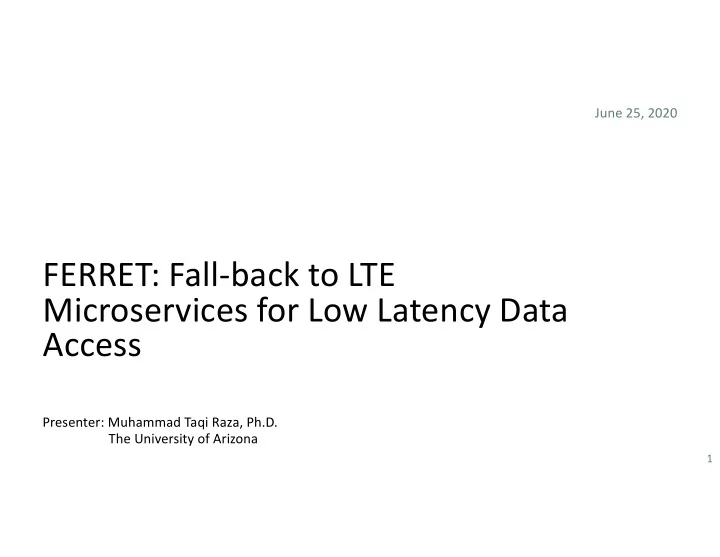

June 25, 2020 FERRET: Fall-back to LTE Microservices for Low Latency Data Access Presenter: Muhammad Taqi Raza, Ph.D. The University of Arizona 1
Background - LTE – LTE Evolved Packet Core (EPC) functionality is divided into control-plane and user-plane . – Control plane logic performs device registration/deregistration, mobility, location update, paging, and many more. – User plane forwards traffic to the next hop along the path to the selected destination network according to control plane logic. LTE Core Network Control-Plane User-Plane HSS S1-AP MME Internet Device Radio Network PDN-Gateway Serving- Gateway 2
Background – IP Multimedia Subsystem (IMS) – Our Use Case Example IMS supports real-time multimedia services. – Voice call request (control plane) – Voice call speech packets flow (user plane) – Regular user data traffic (user plane) IMS Core IMS Signaling (SIP) Telephony Proxy Serving Media IMS Service (RTP/RTCP) Network Server Server Server Data Service Internet SGW PGW 4 LTE EPC IMS Client Radio Network
Existing IMS over LTE – Purpose-built hardware platforms, such as Ericsson’s Blade Systems (EBS), Alcatel-Lucent’s Element Management System (EMS), etc. – Coupling between software and hardware, such as Ericsson’s ERLANG, Alcatel-Lucent’s NVP, etc. – Dedicated network resources for each user. IMS Device Radio Network Internet EPC 4
LTE-NFV Architecture – LTE NFV virtualizes LTE core network functions over off-the-shelf boxes. – This reduces CAPEX and OPEX for operators. Operator Network Internet Radio vEPC Network Network Mang. Mang. Device Radio Network vEPC Data Center 5
Why LTE-NFV Architecture is bad for IMS? – Control plane signaling messages are executed on the cloud – Good : Different vNFs coordinate with each other to facilitate an event (e.g. mobility) – User plane traffic is forwarded to Internet through vEPC Gateways (i.e. Serving Gateway, PDN Gateway, IMS NFs). – Bad : Voice traffic unnecessarily goes through the data center. Operator Network Internet Radio vEPC Network Network Mang. Mang. Device Radio Network vEPC Data Center 6
Data Forwarding through Mobile Edge Compute NF – Let’s decouple control-plane and user-plane – Control-plane traffic still goes to vEPC and vIMS – User-plane traffic is routed through mobile edge compute NFs. Operator Network Internet Radio vEPC Network Network Mang. Mang. Device Radio Network Mobile Edge Compute – We decompose SGW and PGW user plane functionalities and install them at the edge – We also install MGW of IMS at the edge. 7
MEC Design Design Considerations – Decouple LTE and IMS CP and UP and install them at core and edge, respectively. EPC and IMS CP Mobile Edge PGW - C SGW – C PGW – U SGW – U Resource management Change of target GTP-U endpoint IP address allocation Resource management Delay Downlink Data Notification DHCPv4 / DHCPv6 client IP address and TEID assignment IP address and TEID assignment PGW pause of charging Router advertisement Packet forwarding Packet forwarding Accounting for Charging Change of target GTP-U endpoint Transport level packet marking Transport level packet marking Mobility b/w 3GPP and non-3GPP Forwarding of buffered packet Forwarding of buffered packet PGW pause of charging Accounting for Charging Proxy Server (of IMS) Bearer binding UL/DL APN-AMBR enforcement Media Gateway (of IMS) Event reporting UL/DL bearer MBR enforcement Serving Server (of IMS) Redirection UL and DL service level gating UL and DL service level MBR 8
MEC Design Design Considerations: Pure UP and CP Separation – All UP functions are moved to edge, whereas all CP functions (including PCRF, LCS and others) are placed at the core. Issue: – The UP traffic will steer to CP for charging. This adds latencies and bandwidth wastage for voice call operation. Charging Operator Network vEPC Data Center Radio vEPC Network Network Mang. Mang. Device Radio Network Internet Provide copy of all common CP NFs at the edge 9
MEC Design Design Considerations: Share Common Functions between CP and UP – Those functions (e.g. PCRF or charging function) which both CP and UP rely should be shared (i.e. copied). – Let the CP, being central entity, handle the NF allocation. Issue: – Creates race conditions. Example, SGW-U requests SGW-C for relocating SGW-U, while the TAU procedure is ongoing at the core, e.g. MME performs SGW relocation by sending same request to SGW-C. Device SGW-U MME SGW-C Tracking Area Update Req. Relocation Req. Overload (part of TAU) Race Condition Relocation Req. Let UP manage its own resources based on policy provided by CP 10
MEC Design Design Considerations: Share Common Functions between CP and UP Those functions (e.g. PCRF or charging function) which both CP and UP rely should be shared (i.e. copied). Issue: – Creates deadlocks. Example, when ModifyBearer request at CP and UP locks their respective PCRF copies. Device PGW-U PCRF-U MME PGW-C PCRF-C Tracking Area Update Modify Bearer Req. Session Modification Overload Modify Bearer Req. Lock Session Modification Lock Reflect update to PCRF-U Reflect update to PCRF-C Deadlock Use blocking mode operations 11
IMS Application over MEC Realizing IMS Application over MEC through FERRET – VoLTE call requires: (1) Call establishment phase (control plane), and (2) Speech data packets flow (user plane). FERRET Key Idea – Let the CP perform all control-plane operations at the core. NF2 Core – Once all operations are performed at CP, then replay them at the edge. M2 NF1 NF2 M1 M1 – Only transmit VoLTE call control plane packets once the call is established (before user-plane NF1 traffic starts). M2 End 14 Edge
Reducing User Plane Latencies through FERRET – VoLTE call packets are forwarded to the Internet without going to the core. – Baseline results represent operational VoLTE network latencies. – This includes eNodeB <-> vEPC <-> IMS latencies for both caller and callee 13
Summary – MEC is part of 5G agenda that requires important network components to be installed at the edge. – Through IMS, we demonstrate MEC architecture that reduces upto 6X user-plane latencies. – In the future work, we will measure MEC design from different system and networking aspects. – Bandwidth, Latency, Call Rate, Mobility and more. 14
Recommend
More recommend